kublakhan英国文学柯勒律治解析 ppt课件
- 格式:ppt
- 大小:816.00 KB
- 文档页数:32

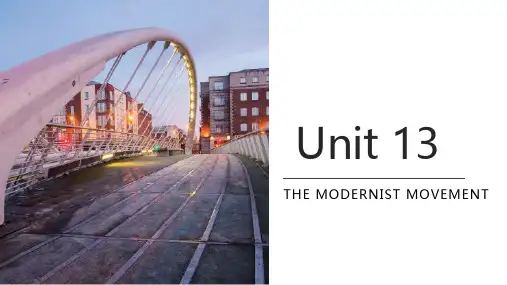
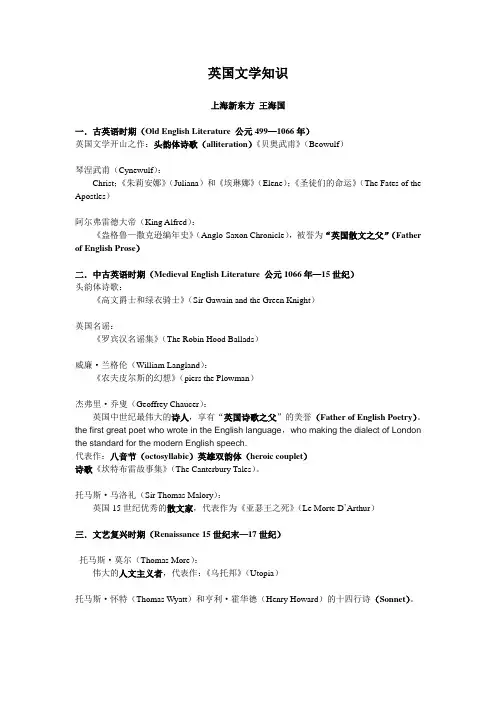
英国文学知识上海新东方王海国一.古英语时期(Old English Literature 公元499—1066年)英国文学开山之作:头韵体诗歌(alliteration)《贝奥武甫》(Beowulf)琴涅武甫(Cynewulf):Christ;《朱莉安娜》(Juliana)和《埃琳娜》(Elene);《圣徒们的命运》(The Fates of the Apostles)阿尔弗雷德大帝(King Alfred):《盎格鲁—撒克逊编年史》(Anglo-Saxon Chronicle),被誉为“英国散文之父”(Father of English Prose)二.中古英语时期(Medieval English Literature 公元1066年—15世纪)头韵体诗歌:《高文爵士和绿衣骑士》(Sir Gawain and the Green Knight)英国名谣:《罗宾汉名谣集》(The Robin Hood Ballads)威廉·兰格伦(William Langland):《农夫皮尔斯的幻想》(piers the Plowman)杰弗里·乔叟(Geoffrey Chaucer):英国中世纪最伟大的诗人,享有“英国诗歌之父”的美誉(Father of English Poetry)。
the first great poet who wrote in the English language,who making the dialect of London the standard for the modern English speech.代表作:八音节(octosyllabic)英雄双韵体(heroic couplet)诗歌《坎特布雷故事集》(The Canterbury Tales)。
托马斯·马洛礼(Sir Thomas Malory):英国15世纪优秀的散文家,代表作为《亚瑟王之死》(Le Morte D’Arthur)三.文艺复兴时期(Renaissance 15世纪末—17世纪)托马斯·莫尔(Thomas More):伟大的人文主义者,代表作:《乌托邦》(Utopia)托马斯·怀特(Thomas Wyatt)和亨利·霍华德(Henry Howard)的十四行诗(Sonnet)。
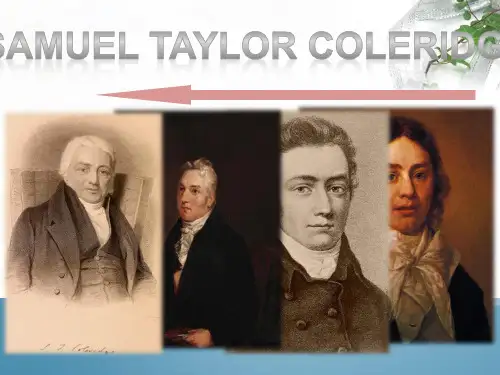
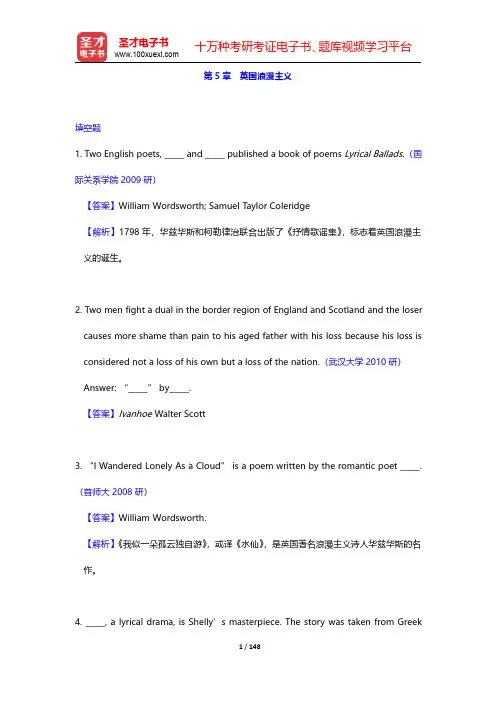
第5章英国浪漫主义填空题1.Two English poets,_____and_____published a book of poems Lyrical Ballads.(国际关系学院2009研)【答案】William Wordsworth;Samuel Taylor Coleridge【解析】1798年,华兹华斯和柯勒律治联合出版了《抒情歌谣集》,标志着英国浪漫主义的诞生。
2.Two men fight a dual in the border region of England and Scotland and the loser causes more shame than pain to his aged father with his loss because his loss is considered not a loss of his own but a loss of the nation.(武汉大学2010研)Answer:“_____”by_____.【答案】Ivanhoe Walter Scott3.“I Wandered Lonely As a Cloud”is a poem written by the romantic poet_____.(首师大2008研)【答案】William Wordsworth.【解析】《我似一朵孤云独自游》,或译《水仙》,是英国著名浪漫主义诗人华兹华斯的名作。
4._____,a lyrical drama,is Shelly’s masterpiece.The story was taken from Greekmythology.(人大2006研)【答案】Oedipus Tyrannus5.William_____based his poetic theory on the principle that“all good poetry is the spontaneous overflow of_____.”(天津外国语学院2011研)【答案】Wordsworth,powerful feeling【解析】(William Wordsworth和Samuel Taylor Coleridge共同出版的Lyrical Ballads《抒情歌谣集》标志着英国浪漫主义的开始。
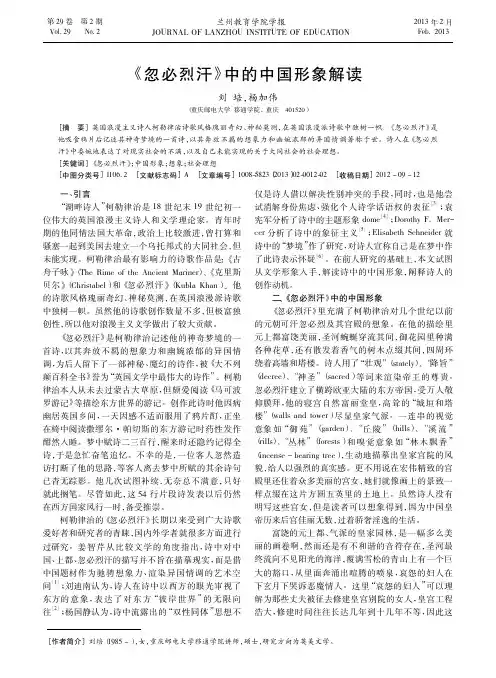
《忽必烈汗》中的中国形象解读刘培,杨加伟(重庆邮电大学移通学院,重庆401520)[摘要]英国浪漫主义诗人柯勒律治诗歌风格瑰丽奇幻、神秘莫测,在英国浪漫派诗歌中独树一帜。
《忽必烈汗》是他吸食鸦片后记述其神奇梦境的一首诗,以其奔放不羁的想象力和幽婉浓郁的异国情调著称于世。
诗人在《忽必烈汗》中委婉地表达了对现实社会的不满,以及自己未能实现的关于大同社会的社会理想。
[关键词]《忽必烈汗》;中国形象;想象;社会理想[中图分类号]I106.2[文献标志码]A[文章编号]1008-5823(2013)02-0012-02[收稿日期]2012-09-12一、引言“湖畔诗人”柯勒律治是18世纪末19世纪初一位伟大的英国浪漫主义诗人和文学理论家。
青年时期的他同情法国大革命,政治上比较激进,曾打算和骚塞一起到美国去建立一个乌托邦式的大同社会,但未能实现。
柯勒律治最有影响力的诗歌作品是:《古舟子咏》(The Rime of the Ancient Mariner)、《克里斯贝尔》(Christabel)和《忽必烈汗》(Kubla Khan)。
他的诗歌风格瑰丽奇幻、神秘莫测,在英国浪漫派诗歌中独树一帜。
虽然他的诗歌创作数量不多,但极富独创性,所以他对浪漫主义文学做出了较大贡献。
《忽必烈汗》是柯勒律治记述他的神奇梦境的一首诗,以其奔放不羁的想象力和幽婉浓郁的异国情调,为后人留下了一部神秘、魔幻的诗作,被《大不列颠百科全书》誉为“英国文学中最伟大的诗作”。
柯勒律治本人从未去过蒙古大草原,但颇爱阅读《马可波罗游记》等描绘东方世界的游记。
创作此诗时他因病幽居英国乡间,一天因感不适而服用了鸦片酊,正坐在椅中阅读撒缪尔·帕切斯的东方游记时药性发作酣然入睡。
梦中赋诗二三百行,醒来时还隐约记得全诗,于是急忙奋笔追忆。
不幸的是,一位客人忽然造访打断了他的思路,等客人离去梦中所赋的其余诗句已杳无踪影。
他几次试图补续,无奈总不满意,只好就此搁笔。

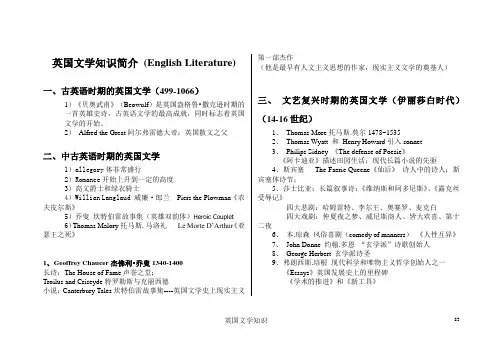
英国文学知识简介(English Literature)一、古英语时期的英国文学(499-1066)1)《贝奥武甫》(Beowulf)是英国盎格鲁•撒克逊时期的一首英雄史诗,古英语文学的最高成就,同时标志着英国文学的开始。
2)Alfred the Great阿尔弗雷德大帝:英国散文之父二、中古英语时期的英国文学1)allegory体非常盛行2)Romance开始上升到一定的高度3)高文爵士和绿衣骑士4)Willian Langlaud 威廉·郎兰Piers the Plowman《农夫皮尔斯》5)乔叟坎特伯雷故事集(英雄双韵体)Heroic Couplet6)Thomas Malory托马斯.马洛礼Le Morte D’Arthur《亚瑟王之死》1、Geoffrey Chaucer杰佛利•乔叟1340-1400长诗:The House of Fame声誉之堂;Troilus and Criseyde特罗勒斯与克丽西德小说:Canterbury Tales坎特伯雷故事集----英国文学史上现实主义第一部杰作(他是最早有人文主义思想的作家,现实主义文学的奠基人)三、文艺复兴时期的英国文学(伊丽莎白时代)(14-16世纪)1、Thomas More托马斯.莫尔1478~15352、Thomas Wyatt 和Henry Howard引入sonnet3、Philips Sidney 《The defense of Poesie》《阿卡迪亚》描述田园生活;现代长篇小说的先驱4、斯宾塞The Faerie Queene《仙后》诗人中的诗人;斯宾塞体诗节;5、莎士比亚:长篇叙事诗:《维纳斯和阿多尼斯》、《露克丝受辱记》四大悲剧:哈姆雷特、李尔王、奥赛罗、麦克白四大戏剧:仲夏夜之梦、威尼斯商人、皆大欢喜、第十二夜6、本.琼森风俗喜剧(comedy of manners)《人性互异》7、John Donne 约翰.多恩“玄学派”诗歌创始人8、George Herbert 玄学派诗圣9、弗朗西斯.培根现代科学和唯物主义哲学创始人之一《Essays》英国发展史上的里程碑《学术的推进》和《新工具》英国文学知识832、Edmund Spenser埃德蒙•斯宾塞1552~1599The Shepherds Calen dar牧人日历Amoretti爱情小唱Epithalamion婚后曲Colin Clouts Come Home Againe柯林•克劳特回来了Foure Hymnes四首赞美歌The Faerie Queene仙后3、Christopher Marlowe柯里斯托弗•马洛1564~1595Tamburlaine帖木耳大帝The Jew of Malta马耳他的犹太人The Tragical History of Doctor Faustus浮士德博士的悲剧4、William Shakespeare莎士比亚1564-1616The Tempest暴风风雨;The Two Gentlemen of V eronaz维罗纳二绅士;The Mercy Wives of Windsor温莎的风流妇人;Measure for Measure恶有恶报;The Comedy of Errors错中错;Much Ado about Nothing无事自扰;Love’s Labour’s Lost空爱一场;A Midsummer Night’s Dream仲夏夜之梦;The Merchant of V enice威尼斯商人;As Y ou Like It如愿;The Taming of the Shrew驯悍记;All’s Well That Ends Well皆大欢喜;Twelfth Night第十二夜;The Winter’s Tale冬天的故事;The Life and Death of King John/Richard the Second/Henry theFifth/Richard the Third约翰王/理查二世/亨利五世/理查三世;The First/Second Part of King Henry the Fourth亨利四世(上、下);The First/Second/Third Part of King Henry the Sixth亨利六世(上、中、下);The Life of King Henry the Eighth亨利八世;Troilus and Cressida脱爱勒斯与克莱西达;The Tragedy of Coriolanus考利欧雷诺斯;Titus Andronicus泰特斯•安庄尼克斯;Romeo and Julet罗密欧与朱丽叶;Timon of Athens雅典的泰门;The Life and Death of Julius Caesar;朱利阿斯•凯撒;The Tragedy of Macbeth麦克白;The Tragedy of Hamlet哈姆雷特/王子复仇记;King Lear李尔王;Othello奥塞罗;Antony and Cleopatra安东尼与克利欧佩特拉;Cymbeline辛白林;Pericles波里克利斯;V enus and Adonis维诺斯•阿都尼斯;Lucrece露克利斯;The Sonnets十四行诗英国文学知识845、Francis Bacon培根1561-1626Advancement of Learning学术的进展;Novum Organum新工具;New Atlantic新大西岛;Essays随笔(Of Studies论学习;Of Wisdom for a Man’s Self)四、启蒙时期(18世纪)1、约翰·弥尔顿:《失乐园》、《为英国人民争辩》2、约翰·班扬:《天路历程》religious allegory3、约翰·德莱顿:英国新古典主义的杰出代表、桂冠诗人;《论戏剧诗》4、亚历山大.蒲柏:英国新古典主义诗歌的重要代表;英雄双韵体的使用达到登峰造极的使用;《田园组诗》是其最早田园诗歌代表作5、托马斯·格雷:感伤主义中墓园诗派的代表人物《墓园挽歌》6、威廉·布莱克:天真之歌、经验之歌;7、罗伯特·彭斯:苏格兰最杰出的农民诗人;8、Richard Steel和Joseph Addison合作创办《The tatler》和《the spectator》9、Samuel defoe 英国现实主义小说的奠基人之一;《鲁滨逊漂流记》;《铲除非国教徒的捷径》,仪表达自己的不满;10、Jonathan Swift 《一个小小的建议》;《格列佛游记》;《桶的故事》;11、Samuel Richardson 英国现代小说的创始人;帕米拉;克拉丽莎;查尔斯.格蓝迪森爵士的历史;12、Henry Fielding 英国现实主义小说理论的奠基人;《约瑟夫。
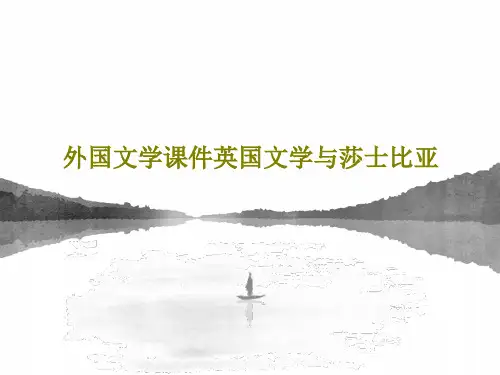
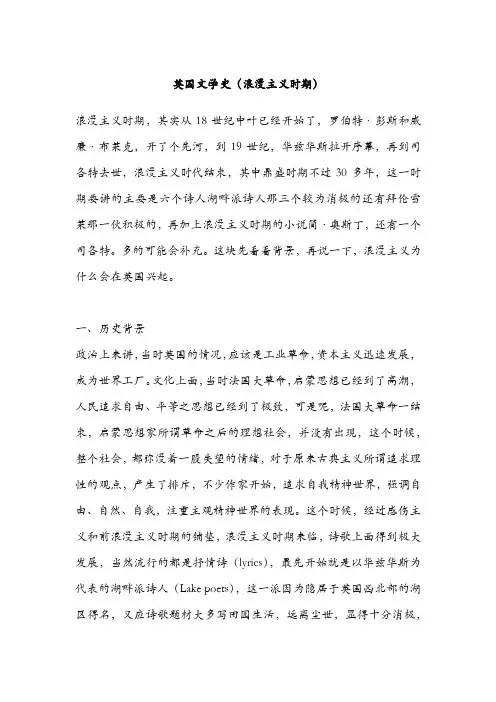
英国文学史(浪漫主义时期)浪漫主义时期,其实从18世纪中叶已经开始了,罗伯特·彭斯和威廉·布莱克,开了个先河,到19世纪,华兹华斯拉开序幕,再到司各特去世,浪漫主义时代结束,其中鼎盛时期不过30多年,这一时期要讲的主要是六个诗人湖畔派诗人那三个较为消极的还有拜伦雪莱那一伙积极的,再加上浪漫主义时期的小说简·奥斯丁,还有一个司各特。
多的可能会补充。
这块先看看背景,再说一下,浪漫主义为什么会在英国兴起。
一、历史背景政治上来讲,当时英国的情况,应该是工业革命,资本主义迅速发展,成为世界工厂。
文化上面,当时法国大革命,启蒙思想已经到了高潮,人民追求自由、平等之思想已经到了极致,可是呢,法国大革命一结束,启蒙思想家所谓革命之后的理想社会,并没有出现,这个时候,整个社会,都弥漫着一股失望的情绪,对于原来古典主义所谓追求理性的观点,产生了排斥,不少作家开始,追求自我精神世界,强调自由、自然、自我,注重主观精神世界的表现。
这个时候,经过感伤主义和前浪漫主义时期的铺垫,浪漫主义时期来临,诗歌上面得到极大发展,当然流行的都是抒情诗(lyrics),最先开始就是以华兹华斯为代表的湖畔派诗人(Lake poets),这一派因为隐居于英国西北部的湖区得名,又应诗歌题材大多写田园生活,远离尘世,显得十分消极,华兹华斯和柯勒律治合编的《抒情歌谣集》(The lyrical ballads)下面先来讲一下,华兹华斯。
二、代表人物诗歌:1、挚爱自然的华兹华斯(William Wordsworth)华兹华斯出生于一个律师家庭,读书的时候,除了学习拉丁语和古典文学就是流连于山水之间,培养对自然的爱好,后来他去了剑桥大学读书,期间,研究斯宾塞,乔叟等人的文学,随后,徒步旅行到法国,被法国革命提出的“自由”、“平等”的口号所吸引,在那里住了一年多,随后“九月大屠杀”和雅各宾派的恐怖统治,大大地浇灭了他对于革命地热情,在朋友的帮助下,在湖区的乡舍中住了两年,这个时期基本热心于创作,期间还认识了柯勒律治,两个人经常相互切磋诗艺,1798年,就联手出版了《抒情歌谣集》,开一代诗风,诗集没出版的时候,华兹华斯就在致力于写作他自己的《序曲》(The Prelude ),后面就是在他离世之前,分别迁过两次,都在湖区住了七八年。
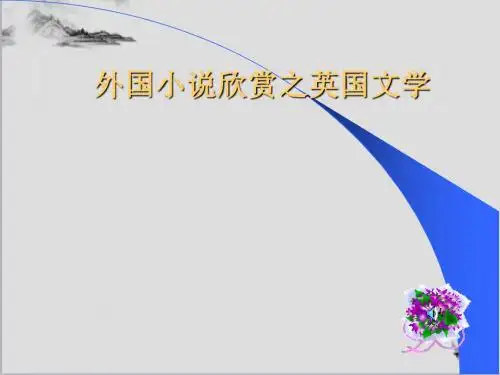
英国文学知识上海新东方王海国一.古英语时期(Old English Literature 公元499—1066年)英国文学开山之作:头韵体诗歌(alliteration)《贝奥武甫》(Beowulf)开德蒙(Caedmon):《赞美诗》(Anthem)琴涅武甫(Cynewulf):《十字架之梦》(Dream of the Rood)比德(Bede):《英吉利人教会史》(Historia Ecclesiastica Gentis Anglorum)阿尔弗雷德大帝(King Alfred):《盎格鲁—撒克逊编年史》(Anglo-Saxon Chronicle),被誉为“英国散文之父”(Father of English Prose)二.中古英语时期(Medieval English Literature 公元1066年—15世纪)头韵体诗歌:《高文爵士和绿衣骑士》(Sir Gawain and the Green Knight)英国名谣:《罗宾汉名谣集》(The Robin Hood Ballads)威廉·兰格伦(William Langland):《农夫皮尔斯的幻想》(The Vision Concerning piers the Plowman)杰弗里·乔叟(Geoffrey Chaucer):英国中世纪最伟大的诗人,享有“英国诗歌之父”的美誉(Father of English Poetry)。
代表作:八音节(octosyllabic)英雄双韵体(heroic couplet)诗歌《坎特布雷故事集》(The Canterbury Tales)。
托马斯·马洛礼(Sir Thomas Malory):英国15世纪优秀的散文家,代表作为《亚瑟王之死》(Le Morte d’Arthur)三.文艺复兴时期(Renaissance 15世纪末—17世纪)托马斯·莫尔(Thomas More):伟大的人文主义者,代表作:《乌托邦》(Utopia),《国王爱德华五世悲戚的一生》(The painful Life of Edwar d Ⅴ).托马斯·魏厄特(Thomas Wyatt)和亨利·霍华德(Henry Howard)的十四行诗(Sonnet)。
一.古英语时期(Old English Literature 公元499—1066年)英国文学开山之作:头韵体诗歌(alliteration)《贝奥武甫》(Beowulf)开德蒙(Caedmon):《赞美诗》(Anthem)琴涅武甫(Cynewulf):《十字架之梦》(Dream of the Rood)比德(Bede):《英吉利人教会史》(Historia Ecclesiastica Gentis Anglorum)阿尔弗雷德大帝(King Alfred):《盎格鲁—撒克逊编年史》(Anglo-Saxon Chronicle),被誉为“英国散文之父”(Father of English Prose)二.中古英语时期(Medieval English Literature 公元1066年—15世纪)头韵体诗歌:《高文爵士和绿衣骑士》(Sir Gawain and the Green Knight)英国名谣:《罗宾汉名谣集》(The Robin Hood Ballads)威廉·兰格伦(William Langland):《农夫皮尔斯的幻想》(The Vision Concerning piers the Plowman)杰弗里·乔叟(Geoffrey Chaucer):英国中世纪最伟大的诗人,享有“英国诗歌之父”的美誉(Father of English Poetry)。
代表作:八音节(octosyllabic)英雄双韵体(heroic couplet)诗歌《坎特布雷故事集》(The Canterbury Tales)。
托马斯·马洛礼(Sir Thomas Malory):英国15世纪优秀的散文家,代表作为《亚瑟王之死》(Le Morte d’Arthur)三.文艺复兴时期(Renaissance 15世纪末—17世纪)托马斯·莫尔(Thomas More):伟大的人文主义者,代表作:《乌托邦》(Utopia),《国王爱德华五世悲戚的一生》(The painful Life of Edwar d Ⅴ).托马斯·魏厄特(Thomas Wyatt)和亨利·霍华德(Henry Howard)的十四行诗(Sonnet)。
Samuel T aylor Coleridge柯勒律治简介1772-1834 Lyrical Ballads;The Fall of the Bastille巴士底狱的毁灭;The Rime of the Ancient Mariner老船夫;Kubla Khan忽必烈汗;Biographia Literaria-96文学传记Introductionborn Oct. 21, 1772, Ottery St. Mary, Devonshire, Eng.died July 25, 1834, Highgate, near LondonSamuel Taylor Coleridge, detail of an oil painting by Washington Allston, 1814; in the National …English lyrical poet, critic, and philosopher. His Lyrical Ballads, written with William Wordsworth, heralded the English Romantic movement, and his Biographia Literaria (1817) is the most significant work of general literary criticism produced in the English Romantic period.Early life and works.Coleridge's father was vicar of Ottery and headmaster of the local grammar school. As a child Coleridge was already a prodigious reader, and he immersed himself to the point of morbid fascination in romances andEastern tales such as The Arabian Nights' Entertainments. In 1781 his father died suddenly, and in the following year Coleridge entered Christ's Hospital in London, where he completed his secondary education. In 1791 he entered Jesus College, Cambridge. At both school and university he continued to read voraciously, particularly in works of imagination and visionary philosophy, and he was remembered by his schoolmates for his eloquence and prodigious memory. In his third year at Cambridge, oppressed by financial difficulties, he went to London and enlisted as a dragoon under the assumed name of Silas Tomkyn Comberbache. Despite his unfitness for the life, he remained until discovered by his friends; he was then bought out by his brothers and restored to Cambridge.On his return, he was restless. The intellectual and political turmoil surrounding the French Revolution had set in motion intense and urgent discussion concerning the nature of society. Coleridge now conceived the design of circumventing the disastrous violence that had destroyed the idealism of the French Revolution by establishing a small society that should organize itself and educate its children according to better principles than those obtaining in the society around them. A chance meeting with the poet Robert Southey led the two men to plan such a “pantisocracy” and to set up a community by the Susquehanna River in Pennsylvania. To this end Coleridge left Cambridge for good and set up with Southey as a public lecturer in Bristol. In October 1795 he married Sara Fricker, daughter of a local schoolmistress, swayed partly by Southey's suggestion that he was under an obligation to her since she had been refusing the advances of other men.Shortly afterward, Southey defected from the pantisocratic scheme, leaving Coleridge married to a woman whom he did not really love. In a sense his career never fully recovered from this blow: if there is a makeshift quality about many of its later events, one explanation can be found in his constant need to reconcile his intellectual aspirations with the financial needs of his family. During this period, however, Coleridge's intellect flowered in an extraordinary manner, as he embarked on an investigation of the nature of the human mind, joined by William Wordsworth, with whom he had become acquainted in 1795. Together they entered upon one of the most influential creative periods of English literature. Coleridge's intellectual ebullience and his belief in the existence of a powerful “life consciousness” in all individuals rescued Wordsworth from the depression into which recent events had cast him and made possible the new approach to nature that characterized his contributions to Lyrical Ballads (which was to be published in 1798).Coleridge, meanwhile, was developing a new, informal mode of poetry in which he could use a conversational tone and rhythm to give unity to apoem. Of these poems, the most successful is “Frost at Midnight,” which begins with the description of a silent frosty night in Somerset and proceeds through a meditation on the relationship between the quiet work of frost and the quiet breathing of the sleeping baby at the poet's side, to conclude in a resolve that his child shall be brought up as a “child of nature,” so that the sympathies that the poet has come to detect may be reinforced throughout the child's education.At the climax of the poem, he touches another theme, which lies at the root of his philosophical attitude:. . . so shalt thou see and hearThe lovely shapes and sounds intelligibleOf that eternal language, which thy GodUtters, who from eternity doth teachHimself in all, and all things in himself.Coleridg e's attempts to learn this “language” and trace it through the ancient traditions of mankind also led him during this period to return to the visionary interests of his schooldays: as he ransacked works of comparative religion and mythology, he was exploring the possibility that all religions and mythical traditions, with their general agreement on the unity of God and the immortality of the soul, sprang from a universal life consciousness, which was expressed particularly through the phenomena of human genius.While these speculations were at their most intense, he retired to a lonely farmhouse near Culbone, Somersetshire, and, according to his own account, composed under the influence of laudanum the mysterious poetic fragment known as “Kubla Khan.” The ex otic imagery and rhythmic chant of this poem have led many critics to conclude that it should be read as a “meaningless reverie” and enjoyed merely for its vivid and sensuous qualities. An examination of the poem in the light of Coleridge's psychological and mythological interests, however, suggests that it has, after all, a complex structure of meaning and is basically a poem about the nature of human genius. The first two stanzas show the two sides of what Coleridge elsewhere calls “commanding genius”: it s creative aspirations in time of peace as symbolized in the projected pleasure dome and gardens of the first stanza; and its destructive power in time of turbulence as symbolized in the wailing woman, the destructive fountain, and the voices prophesying war of the second stanza. In the final stanza the poet writes of a state of “absolute genius” in which, if inspired by a visionary “Abyssinian maid,” he would become endowed with the creative, divine power of a sun god—an Apollo or Osiris subduing all around him to harmony by the fascination of his spell.Coleridge was enabled to explore the same range of themes less egotistically in “The Rime of the Ancient Mariner,” composed during the autumn and winter of 1797–98. For this, his most famous poem, he drew upon the ballad form. The main narrative tells how a sailor who has committed a crime against the life principle by slaying an albatross suffers from torments, physical and mental, in which the nature of his crime is made known to him. The underlying life power against which he has transgressed is envisaged as a power corresponding to the influx of the sun's energy into all living creatures, thereby binding them together in a joyful communion. By killing the bird that hovered near the ship, the mariner has destroyed one of the links in this process. His own consciousness is consequently affected: the sun, previously glorious, is seen as a bloody sun, and the energies of the deep are seen as corrupt.All in a hot and copper sky,The bloody Sun, at noon,Right up above the mast did stand,No bigger than the Moon.. . . . . . . . . . . . . . . . . . . . . . . .The very deep did rot; O Christ!That ever this should be!Yea, slimy things did crawl with legsUpon the slimy sea.Only at night do these energies display a sinister beauty.About, about, in reel and routThe death-fires danced at night;The water, like a witch's oils,Burnt green, and blue and white.After the death of his shipmates, alone and becalmed, devoid of a sense of movement or even of time passing, the mariner is in a hell created by the absence of any link with life. Eventually, however, a chance sight of water snakes flashing like golden fire in the darkness, answered by an outpouring of love from his heart, reinitiates the creative process: he is given a brief vision of the inner unity of the universe, in which all living things hymn their source in an interchange of harmonies. Restored to his native land, he remains haunted by what he has experienced but is at least delivered from nightmare, able to see the ordinary processes of human life with a new sense of their wonder and mercifulness. These last qualities are reflected in the poem's attractive combination of vividness and sensitivity. The placing of it at the beginning of Lyrical Ballads was evidently intended to provide a context for the sense of wonder in common life that marks many of Wordsworth's contributions. While thisvolume was going through the press, Coleridge began a complementary poem, a Gothic ballad entitled “Christabel,” in which he aimed to show how naked energy might be redeemed through contact with a spirit of innocent love.Troubled years.Early in 1798 Coleridge had again found himself preoccupied with political issues. The French Revolutionary government had suppressed the states of the Swiss Confederation, and Coleridge expressed his bitterness at this betrayal of the principles of the Revolution in a poem entitled “France: An Ode.”At this time the brothers Josiah and Thomas Wedgwood, who were impressed by Coleridge's intelligence and promise, offered him in 1798 an annuity of £150 as a means of subsistence while he pursued his intellectual concerns. He used his new independence to visit Germany with Wordsworth and Wordsworth's sister, Dorothy. While there Coleridge attended lectures on physiology and biblical criticism at Göttingen. He thus became aware of developments in German scholarship that were little-known in England until many years later.On his return to England, the tensions of his marriage were exacerbated when he fell in love with Sara Hutchinson, the sister of Wordsworth's future wife, at the end of 1799. His devotion to the Wordsworths in general did little to help matters, and for some years afterward Coleridge was troubled by domestic strife, accompanied by the worsening of his health and by his increasing dependence on opium. His main literary achievements during the period included another section of “Christabel.” In 1802 Coleridge's domestic unhappiness gave rise to “Dejection: An Ode,” originally a longer verse letter sent to Sara Hutchinson in which he lamented the corrosive effect of his intellectual activities when undertaken as a refuge from the lovelessness of his family life. The poem employs the technique of his conversational poems; the sensitive rhythms and phrasing that he had learned to use in them are here masterfully deployed to represent his own depressed state of mind.Although Coleridge hoped to combine a platonic love for Sara with fidelity to his wife and children and to draw sustenance from the Wordsworth household, his hopes were not realized, and his health deteriorated further. He therefore resolved to spend some time in a warmer climate and, late in 1804, accepted a post in Malta as secretary to the acting governor.Later he spent a long time journeying across Italy, but, despite his hopes, his health did not improve during his time abroad. The time spent in Malta had been a time of personal reappraisal, however. Brought into direct contact with men accustomed to handling affairs of state, he had found himself lacking an equal forcefulness and felt that in consequence he often forfeited the respect of others. On his return to England he resolved to become more manly and decisive. Within a few months he had finally decided to separate from his wife and to live for the time being with the Wordsworths. Southey atoned for his disastrous youthful advice by exercising a general oversight of Coleridge's family for the rest of his days.Coleridge published a periodical, The Friend,from June 1809 to March 1810 and ceased only when Sara Hutchinson, who had been acting as amanuensis, found the strain of the relationship too much for her and retired to her brother's farm in Wales. Coleridge, resentful that Wordsworth should apparently have encouraged his sister-in-law's withdrawal, resolved shortly afterward to terminate his working relationship with William and Dorothy Wordsworth and to settle in London again.The period immediately following was the darkest of his life. His disappointment with Wordsworth was followed by anguish when a wounding remark of Wordsworth's was carelessly reported to him. For some time he remained in London, nursing his grievances and producing little. Opium retained its powerful hold on him, and the writings that survive from this period are redolent of unhappiness, with self-dramatization veering toward self-pity.In spite of this, however, there also appear signs of a slow revival, principally because for the first time Coleridge knew what it was to be a fashionable figure. A course of lectures he delivered during the winter of 1811–12 attracted a large audience; for many years Coleridge had been fascinated by William Shakespeare's achievement, and his psychological interpretations of the chief characters were new and exciting to his contemporaries. During this period, Coleridge's play Osorio, written many years before, was produced at Drury Lane with the title Remorse in January 1813.Late life and works.In the end, consolation came from an unexpected source. In dejection, unable to produce extended work or break the opium habit, he spent a longperiod with friends in Wiltshire, where he was introduced to Archbishop Robert Leighton's commentary on the First Letter of Peter. In the writings of this 17th-century divine, he found a combination of tenderness and sanctity that appealed deeply to him and seemed to offer an attitude to life that he himself could fall back on. The discovery marks an important shift of balance in his intellectual attitudes. Christianity, hitherto one point of reference for him, now became his “official” creed. By aligning himself with the Anglican church of the 17th century at its best, he hoped to find a firm point of reference that would both keep him in communication with orthodox Christians of his time (thus giving him the social approval he always needed, even if only from a small group of friends) and enable him to pursue his former intellectual explorations in the hope of reaching a Christian synthesis that might help to revitalize the English church both intellectually and emotionally.One effect of the adoption of this basis for his intellectual and emotional life was a sense of liberation and an ability to produce large works again. He drew together a collection of his poems (published in 1817 as Sibylline Leaves) and wrote Biographia Literaria(1817), a rambling and discursive but highly stimulating and influential work in which he outlined the evolution of his thought and developed an extended critique of Wordsworth's poems.For the general reader Biographia Literaria is a misleading volume, since it moves bewilderingly between autobiography, abstruse philosophical discussion, and literary criticism. It has, however, an internal coherence of its own. The book's individual components—first an entertaining account of Coleridge's early life, then an account of the ways in which he became dissatisfied with the associationist theories of David Hartley and other 18th-century philosophers, then a reasoned critique of Wordsworth's poems—are fascinating. Over the whole work hovers Coleridge's veneration for the power of imagination: once this key is grasped, the unity of the work becomes evident.A new dramatic piece, Zapolya, was also published in 1817. In the same year, Coleridge became associated for a time with the new Encyclopaedia Metropolitana, for which he planned a novel system of organization, outlined in his Prospectus.These were more settled years for Coleridge. Since 1816 he had lived in the house of James Gillman, a surgeon at Highgate, north of London. His election as a fellow of the Royal Society of Literature in 1824 brought him an annuity of £105 and a sense of recognition. In 1830 he joined the controversy that had arisen around the issue of Catholic Emancipation by writing his last prose work, On the Constitution of the Church and State. The third edition of Coleridge'sPoetical Works appeared in time for him to see it before his final illness and death in 1834.Evaluation.Coleridge's achievement has been given more widely varying assessments than that of any other English literary artist, though there is broad agreement that his enormous potential was never fully realized in his works. His stature as a poet has never been in doubt; in “Kubla Khan” and “The Rime of the Ancient Mariner” he wrote two of the greatest poems in English literature and perfected a mode of sensuous lyricism that is often echoed by later poets. But he also has a reputation as one of the most important of all English literary critics, largely on the basis of his Biographia Literaria.In Coleridge's view, the essential element of literature was a union of emotion and thought that he described as imagination. He especially stressed poetry's capacity for integrating the universal and the particular, the objective and the subjective, the generic and the individual. The function of criticism for Coleridge was to discern these elements and to lift them into conscious awareness, rather than merely to prescribe or to describe rules or forms.In all his roles, as poet, social critic, literary critic, theologian, and psychologist, Coleridge expressed a profound concern with elucidating an underlying creative principle that is fundamental to both human beings and the universe as a whole. To Coleridge, imagination is the archetype of this unifying force because it represents the means by which the twin human capacities for intuitive, non-rational understanding and for organizing and discriminating thought concerning the material world are reconciled. It was by means of this sort of reconciliation of opposites that Coleridge attempted, with considerable success, to combine a sense of the universal and ideal with an acute observation of the particular and sensory in his own poetry and in his criticism.John Bernard Beer Ed.Additional ReadingRichard Holmes, Coleridge: Early Visions (1990), and Coleridge: Darker Reflections (1998), are together a comprehensive biography. Norman Fruman, Coleridge, the Damaged Archangel(1971), offers a detailed account of hisborrowings from other authors. Basil Willey, Samuel Taylor Coleridge(1972); and Katharine Cooke, Coleridge(1979), are useful general surveys of his work in both prose and verse. Among the studies of his poetry are John LivingstonLowes, The Road to Xanadu: A Study in the Ways of the Imagination (1927, reprinted 1986); Stephen Potter, Coleridge and S.T.C.(1935, reissued 1965);G. Wilson Knight, The Starlit Dome: Studies in the Poetry of Vision (1941, reissued 1971); Stephen Prickett, Coleridge and Wordsworth: The Poetry of Growth (1970, reprinted 1980); John B. Beer(ed.), Coleridge's Variety: Bicentenary Studies (1974); and J. Robert Barth, Coleridge and the Power of Love (1988). The poet's politics are examined in Nicholas Roe, Wordsworth and Coleridge: The Radical Years (1988); and John Morrow, Coleridge's Political Thought (1990). Other critical analyses include J.A. Appleyard, Coleridge's Philosophy of Literature(1965); Thomas McFarland, Coleridge and the Pantheist Tradition (1969); Ian Wylie, Young Coleridge and the Philosophers of Nature (1989); Paul Hamilton, Coleridge's Poetics (1983); K.M. Wheeler, The Creative Mind in Coleridge's Poetry(1981); and Catherine Miles Wallace, The Design of Biographia Literaria (1983).。
Part onethe first peak of English literatureFour great writers:Wycli 威克利夫translation of the BibleGower 哥瓦V ox Clamantis呼号者的声音Langland朗格兰Piers the Plowman 农夫彼尔斯Unknown writer Romance罗曼史Chaucer乔叟French period:The Remount of the RoseItalian period:Troilus and Criseyde特利勒斯与克丽西达England period:the Canterbury Tales坎特伯雷故事集The 15th century of English literaturePoetry :popular ballads大众歌谣:Robin hood ballads罗宾汉Border ballads边塞歌谣Arthurian ballads亚瑟王Prose:Malory马罗礼Le morte D’Arther亚瑟王之死Part twoThe first stage of the RenaissanceMore莫乐Utopia(Nowhere)乌托邦Wyatt魏阿特first man to introduce into England sonnetSurrey 萨利first man to reform sonnet/first man to use blank verse/first to use sonnet seriesThe second stage if the renaissanceCourt poetry:Sidney 锡特尼Astrophel and Stella阿斯特罗飞尔与斯黛拉Apology for Poetry诗辩The first englih literary critic /the first English pragametic poetSpenser 斯宾塞The Farie Queen 仙后Prose fiction:Lily 李蕾Euphues or the Anatomyof WYT尤菲倚斯或智慧的剖析Pre-shakespearian Dranatists:Marlowe 马洛Doctor Eaustus浮士德博士Shakespeare莎士比亚First Period:1592 RichardⅢ理查德三世1593 the taming of the shrew驯悍记1594 romeo and Juliet 罗密欧与茱丽叶Second period: 1595 a mid summer night’s dream仲夏夜之梦1596 the merchant of V enice 威尼斯商人1597henryⅣ亨利四世1598the merry wives if windsor温莎的风流情妇1599Julius Caesar凯撒大帝Third period: 1601Hamlet哈姆雷特1604Measure for measure量罪记Othello 奥赛罗1605 king lear 李尔王Mabech 麦克白Timon of Athens 雅典的泰门Fourth period: 1611 the tempest 暴风雨The third stage of the renaissanceDrama:Beawmont鲍茫and Fletcher弗莱戚The maid’s Tragedy少女的悲剧ProseBacon培根Advance of learning学术的进展New Instrument新工具Essays论文集Part threeEnglish literature of the renaissanceJohn Bunyan班扬The Pilgrim’s Progress天路历程John Dryden All for loveAn essay of dramatic poesyJohn Milton The defense of the peopleThe second defense of the English peopleParadise lost失乐园Paradise RegainedSamson AgibustersPart fourThe first stage if the 18th C E LPoetry:Pope 蒲伯Pastoral Poems田园诗:Windsor Forest温莎林Philosophical poems 哲理诗:Essay on manDidactic poems教诲诗:Essay on CritismSatirical poems讽刺诗:The rape of the lock 卷发遇劫记Prose Periodical literature报刊文学:Steel 斯梯尔The Tatler闲话报Addison 艾迪生The Spectator旁观者Novel:Defoe 笛福first father of English novelRobinson Crusoe鲁滨孙漂流记Captain Singleton辛格顿船长Moll Flanders摩尔弗兰德斯Colonel Jack杰克上校Roxana罗克萨娜Swift 斯威夫特The battle of books 书籍之战A tale of a Tub 一个桶子的故事Gulliver’s Travel格列佛游记The second stage of the 18th centuryNovelRichardson 理查逊the second father of English novelPamela ,or, virtue Rewarded帕米拉或贞洁得报Clarissa Harlowe克拉瑞萨Sir charles Grandison 格兰狄生Fielding 菲尔丁Tom Jones,a founding弃儿汤姆琼斯Joseph Andrews 约瑟夫安矶尔Jonathan Wild the Great大伟人江奈生魏尔德Amelia艾米丽Smollett斯摩莱特The RegicideRoderick RandomPeregrine Pickle柏尔葛论辟克尔Humphry Clinker韩富瑞克拉克Prose:Johnson 约翰逊compile a dictionary of the English languageBoswel鲍斯威尔Life of Johnson约翰逊博士生平The third stage of 18th C E LSentimentalism感伤主义:Goldsmith 哥尔斯密诗歌:the deserted village荒村小说:the Vicar of wakefield威客菲牧师散文:the citizen of the world世界公民Sterne 斯泰恩The life and opinions of Tristram Shandy特利斯川项狄的生平与见解William Blake 布莱克songs of Innocence天真之歌Songs of Experience经验之歌Sheridan谢拉丹the ricals情敌The school for scandal造谣学校Pre-romanticism:Percy 伯西主教Reliques of ancient English poetry 英国古诗遗Chevy chase 切维山追猎Battle of Otterburn 俄代本战役创作手法:collectionJames Macpherson麦克菲生ossian欧辛集创作手法:collection and forgeryThomas Chatterton 杰脱顿The Rowley Papers 罗雷小抄创作手法:forgeryRobert Burns 彭斯national poet of SctlandPART 5 romanticsm in england(1798-1832)Section 2 passive romanticists1.Wordsworth 华兹华斯《The Solidary Reaper》孤独的刈禾女《ComposedUpon Westminster Bridge》西敏桥上有感2.Coleridge柯勒律治《The rime of the ancient mariner》老水手之歌《Kubla khan》忽必烈汗《Christabel》克丽司脱倍3.Southey 骚塞Section 3 active romanticists1.Byron 拜伦成名作《Childe harold’s pilgrimage》查尔德-哈洛德游记1812.1817,1818《Dan Juan》唐璜1818-1823<Oriental tales><Hebrew melodies><The prisoner of chillion><.Manfred><Cain>2.Shelley 雪莱Political lyric <Song to the men of england>给英国人民的歌Natural lyric <Ode to the west wind>西风颂<Queen Mab>麦布女王.<The revolt of islam>伊斯兰反叛.<Prometheus unbound>解放的普罗米修斯.<The cenci>沉西.<The masaue of anarchy>专制魔王的化装游行3.Keats 济慈<On the grasshopper and cricket>蝈蝈于蟋蟀(十四行诗,歌颂ever-beautiful nature)<Endymiom>安狄米恩<Ode to a nightingale>夜莺颂。